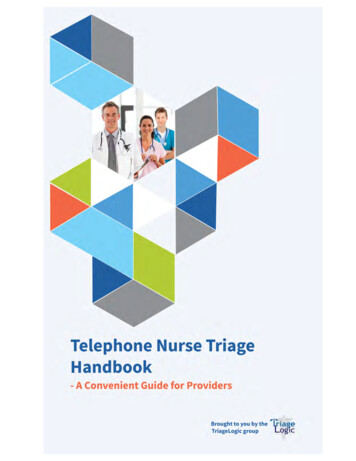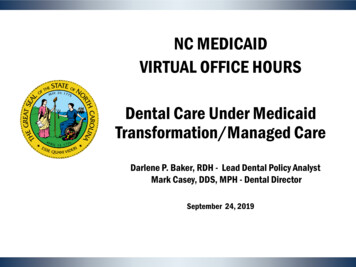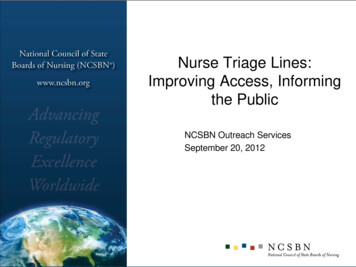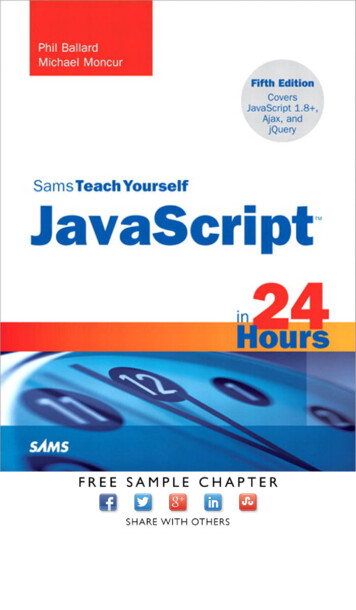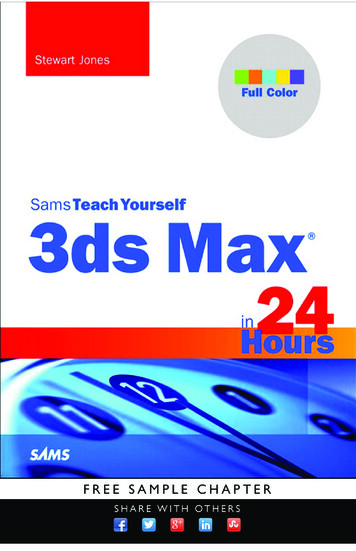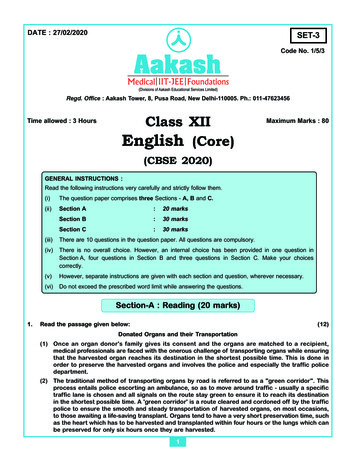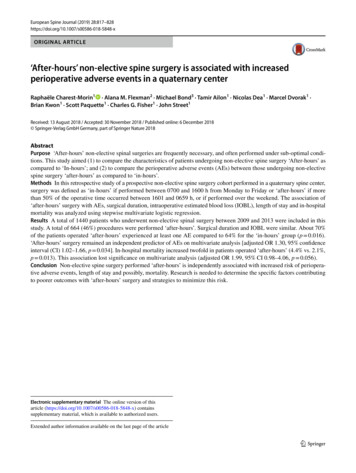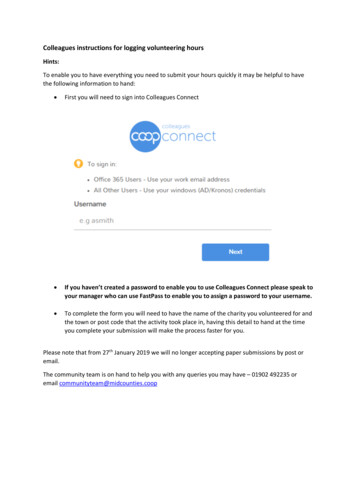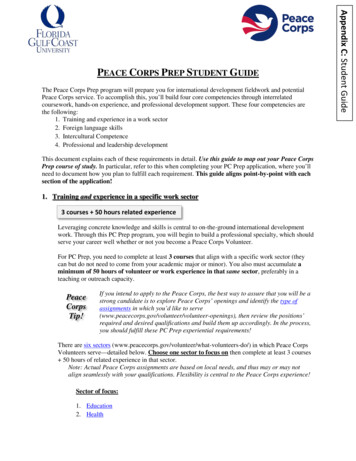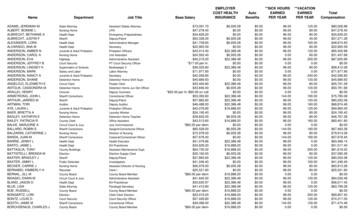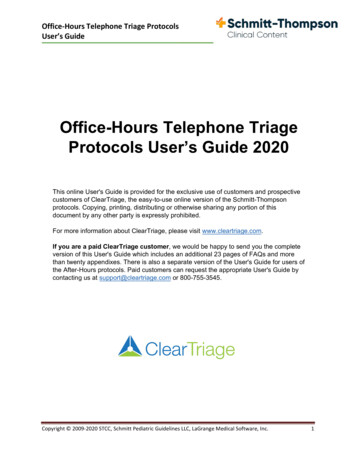
Transcription
Office-Hours Telephone Triage ProtocolsUser’s GuideOffice-Hours Telephone TriageProtocols User’s Guide 2020This online User's Guide is provided for the exclusive use of customers and prospectivecustomers of ClearTriage, the easy-to-use online version of the Schmitt-Thompsonprotocols. Copying, printing, distributing or otherwise sharing any portion of thisdocument by any other party is expressly prohibited.For more information about ClearTriage, please visit www.cleartriage.com.If you are a paid ClearTriage customer, we would be happy to send you the completeversion of this User's Guide which includes an additional 23 pages of FAQs and morethan twenty appendixes. There is also a separate version of the User's Guide for users ofthe After-Hours protocols. Paid customers can request the appropriate User's Guide bycontacting us at support@cleartriage.com or 800-755-3545.Copyright 2009-2020 STCC, Schmitt Pediatric Guidelines LLC, LaGrange Medical Software, Inc.1
Office-Hours Telephone Triage ProtocolsUser’s GuideContentsContents . 2Schmitt-Thompson Clinical Content (STCC) . 3Introduction . 3Benefits of Telephone Triage Protocols . 3Number of Protocols . 4Structure of Protocols. 4Structure of a Telephone Triage Encounter. 10Overview . 10Introduce Self to Caller . 10Collect or Confirm Demographic Information . 11Obtain a Brief Health History. 11Document a Brief Description of the Patient’s Illness . 11Select the Correct Protocol. 13Triage – Ask the Triage Questions . 13Select an Appropriate Disposition . 14Additional Factors that May Influence Disposition . 15Provide Care Advice (Telephone Advice). 16Give Call-Back Instructions . 17Practice Risk Management Strategies to Prevent Adverse Outcomes . 18Copyright 2009-2020 STCC, Schmitt Pediatric Guidelines LLC, LaGrange Medical Software, Inc.2
Office-Hours Telephone Triage ProtocolsUser’s GuideSchmitt-Thompson Clinical Content (STCC)Introduction The Schmitt (pediatric) and Thompson (adult) telephone protocols are decision-support tools fortelephone care providers (TCPs).They assist the TCP through the data collection, triage, decision-making, disposition selectionand advice-giving processes.Most telephone triagers are registered nurses with special advanced training.The use of protocols by nurses who work in medical call centers is recommended by theAmerican Academy of Pediatrics, the American Accreditation Health Care Commission, andother risk management groups.In most states, the Nurse Practice Act requires that nurses use standardized protocols if they areproviding telephone triage and giving advice. Reason: Giving any medical advice to callers islegally deemed as medical practice. The supervising physician is responsible for all medicaladvice given, no matter who gives it. Using protocols ensures the nurse is functioning within thenursing scope of practice.Benefits of Telephone Triage ProtocolsThere are many benefits of using telephone triage protocols, including the following:Provide standardized approachto telephone triage Improve consistency of the home care advice offered bytelephone nurses Provide a consensus tool for physicians across a healthcaresystem regarding how telephone care will be deliveredReduce telephone errors andlegal liability Prevent omission of important questions Provide a focus for review of nurse performance Allow physicians to safely delegate calls to nursesImprove efficiency Keep the assessment process thorough and logical Simplify training and education of staff Allow documentation by exceptionCopyright 2009-2020 STCC, Schmitt Pediatric Guidelines LLC, LaGrange Medical Software, Inc.3
Office-Hours Telephone Triage ProtocolsUser’s GuideNumber of Protocols Currently there are 249 active pediatric Office-Hours protocols (see Appendix A), including 20behavioral health protocols (see Appendix T).Currently there are a total of 212 active adult Office-Hours protocols (see Appendix B), including46 adult women’s health protocols (see Appendix C) and 12 behavioral health protocols (seeAppendix U).This set of telephone triage protocols covers over 90% of medical calls.Structure of ProtocolsThe pediatric and adult Office-Hours protocols have identical organization and structure. Each set ofprotocols include the following 10 components which are described further in the sections below:1.2.3.4.5.6.7. See More Appropriate Protocols(SMAP) Questions8. Triage Questions9. Care Advice10. CitationsTitle (Topic Name)Search WordsDefinitionBackground InformationFirst AidReferencesTitle (Topic Name) The adult and pediatric protocols nearly always have identical titles. This makes it easier for thetriager to transition between protocol sets.Most protocols are symptom-based (e.g., Cough, Vomiting).Exposure protocols are available for some illnesses (e.g., Influenza Exposure)Disease-based protocols are also included (Table 1).Table 1: Examples of Disease Based ProtocolsExamplesDisease-Based ProtocolsChronic Disease previously diagnosed by a healthcare provider Asthma AttackCommon acute diseases that could reliably bediagnosed by most adults Athlete’s FootHead LicePregnancy and Postpartum Conditions (Adult) Pregnancy – Decreased Fetal MovementPregnancy – Morning SicknessPostpartum – Vaginal Bleeding and LochiaFollow-up Call protocols for managing callsregarding recently diagnosed acute diseases Ear Infection Follow-Up CallUrinalysis Results Tract Follow-Up CallCopyright 2009-2020 STCC, Schmitt Pediatric Guidelines LLC, LaGrange Medical Software, Inc.4
Office-Hours Telephone Triage ProtocolsUser’s GuideSearch Words Search words are carefully selected for each protocol.These search words help the nurse triager find the most appropriate protocol available to usefor that specific symptom or concern.Based on the results of search word testing, new search words are added each year.Search words that bring up unrelated protocols are also deleted each year.Definition This section defines the symptoms that need to be present before using this protocol.Some symptoms are straightforward (e.g., Headache).Other symptoms require clarification (e.g., Constipation).For disease-based topics, diagnostic criteria for that disease are listed. The disease-basedprotocols should only be used if the caller’s description of symptoms matches the symptomslisted in the definition section for that disease.Example of Diagnostic Criteria for Disease-based Guideline: Athlete’s Foot - PediatricUse this guideline only if the patient has symptoms that match Athlete's FootSYMPTOMS OF ATHLETE'S FOOT INCLUDE:* Red, scaly, cracked rash between the toes* The rash itches and burns* With itching, the rash becomes raw and weepy* Often involves the insteps of the feet* Unpleasant foot odor* Mainly in adolescents. Prior to age 10, it's usually something else.Background Information (BI) This section includes additional clinical information to help nurses improve their clinicalreasoning (critical thinking skills) and fine tune their assessment skills.Causes are included for symptom-based protocols.Complications are included for disease-based protocols.Reasons behind any triage or treatments that are controversial are also discussed.When call centers ask the authors questions, we respond directly. If it is a frequent question,we also add the response to the background information.Copyright 2009-2020 STCC, Schmitt Pediatric Guidelines LLC, LaGrange Medical Software, Inc.5
Office-Hours Telephone Triage ProtocolsUser’s GuideFirst Aid This section allows the triager to quickly find first-aid instructions forany patient who has a life-threatening or serious emergency.First aid minimizes injury and damage before the patient is transportedto the emergency department (ED) or office.Examples are giving an epinephrine injection for a probableanaphylactic reaction and applying cold water to a new burn.Disposition Categories or Levels of Care The main objective of telephone triage is to sort patients into appropriate dispositions (triagecategories) based on acuity or severity of the illness. The disposition categories are thekeystone of a telephone triage and advice systems.They range from emergent care to home care. Table 2 includes the nine main Office-HoursDisposition Levels.Table 2: Office-Hours Disposition CategoriesDispositionCall Emergency Medical Services(911) NowGo to the ED Now (by car)Go to the ED/UCC Now (or toOffice with PCP Approval):URGENCYGo to Office NowSee Today in Office*See Today or Tomorrow in Office*See Within 3 Days in Office*See Within 2 Weeks in Office*Home Care (Self-Care)*By AppointmentDescriptionPatients with life-threatening emergenciesPatients with emergent symptoms that requireemergency department resourcesPatients with emergent symptoms that can beevaluated and managed in some offices.Discuss the best site with the PCP.Patients with less emergent symptoms whocan be evaluated in most office settings.See during office session (half day), preferablywithin 2 hoursPatients with urgent symptoms and patientswho are very uncomfortable. Includes manycallers who request to be seen.Patients with non-urgent symptomsPatients with persistent symptoms that arenot becoming worsePatients with chronic or recurrent symptomsthat are not becoming worsePatients with mild symptoms that can bemanaged at home with care advice andcontinued monitoringCopyright 2009-2020 STCC, Schmitt Pediatric Guidelines LLC, LaGrange Medical Software, Inc.6
Office-Hours Telephone Triage ProtocolsUser’s Guide The protocols contain many other dispositions that are needed for less common clinicalscenarios. Examples are referrals to dentists, other local agencies such as poison centers, suicidehotlines, and social services for possible abuse situations.The adult protocols are supported by 35 dispositions (see Appendix D).The pediatric protocols are supported by 31 dispositions (see Appendix D—excluding the 4 OBand L&D dispositions that support the adult population).See More Appropriate Protocol (SMAP) Questions The purpose of a SMAP question is to prompt the triage nurse to consider a more appropriateprotocol that best addresses the caller’s chief complaint.For symptom-based protocols, the SMAP may redirect the triager to a more specific diseasebased protocol. For example, the triager may initially select the Rash or Redness–Widespreadprotocol. If Swimmer’s Itch is suspected (rash is consistent with the clinical presentation ofSwimmer’s Itch), a SMAP would prompt the triager go to the Swimmer’s Itch protocol.For disease-based protocols, if the diagnostic criteria are not met, the triage nurse is redirectedto the appropriate symptom protocol (e.g., from Ringworm to Rash or Redness–Localized).The SMAP questions are especially helpful to new nurses. Using the most appropriate protocolhelps assure that the triager selects the most appropriate disposition and targeted care advice.The SMAP section is found towards the beginning of the triage protocol section, but always afterthe 911 triage questions.Examples of Office-Hours SMAP QuestionsGuideline: Fever - PediatricSeizure occurredGo to Protocol: Seizure with Fever (Pediatric - Office Hours)Fever onset within 24 hours of receiving an immunizationGo to Protocol: Immunization Reactions (Pediatric-Office Hours)Confused talking or behavior (delirious) with feverGo to Protocol: Confusion-Delirium (Pediatric – Office Hours)Exposure to high environmental temperaturesGo to Protocol: Heat Exposure (Pediatric – Office Hours)Copyright 2009-2020 STCC, Schmitt Pediatric Guidelines LLC, LaGrange Medical Software, Inc.7
Office-Hours Telephone Triage ProtocolsUser’s GuideTriage Questions The triage questions are grouped within dispositions and are sequenced from highest to lowestacuity (from most serious to least serious diagnoses or complications) as outlined in diagram below.Questions to detect life-threatening emergencies that require EMS.Questions to detect potential emergent or urgent conditions that need to beseen now or in next 4 hours (e.g., cellulitis, severe pain).Questions to detect non-urgent, moderately sick patients that need to be seen innext 24 hours (usually do not need to be seen after-hours unless office not open innext 24 hours) (e.g., UTI, earache).Questions to detect persistent symptoms that are very low risk for complicationsthat can be seen in 3 days (e.g., nasal allergies, localized rashes).Questions to detect chronic or recurrent symptoms that are not becoming worse andthat can be see in next 1-2 weeks.Questions to detect mild symptoms that can be safely treated at home and monitored further(e.g., small cut or abrasion).Care Advice This section contains care advice for the delayed dispositions (See Today down to Home Care).Note: Unlike After-Hours protocols, the care advice in Office-Hours is not targeted towardsspecific triage questions. Generally, most Office-Hours advice is meant for “Home Care”patients or those patients that will be seen later by appointment.For patients who are referred in immediately, the nurse may only give first aid or pain controladvice. These patients will get the rest of the care advice in the ED or office when seen.Limited interim care advice is offered for patients who will be seen by appointment the next dayor later. The patients will receive the rest of the care advice after they are evaluated in amedical setting.All of the care advice is written in lay person’s language.The treatment advice is written in an action statement format. It’s also written directly for thecaller. Therefore, the triager can use it as a script.The care advice often starts with a reassurance statement. Reassurance may be just as helpfulto the caller as specific treatment advice.Each piece of care advice is preceded by a topic heading (e.g., Fever Medicine, Cleanse theWound). These headings help you efficiently scan care advice items and jog your memory.The reason for giving that advice is also often included.Copyright 2009-2020 STCC, Schmitt Pediatric Guidelines LLC, LaGrange Medical Software, Inc.8
Office-Hours Telephone Triage ProtocolsUser’s GuideExample of Care Advice from Protocol: Fever - ce of fever means your child has an infection, usually caused by a virus.Most fevers are good for sick children and help the body fight infectionTopic Heading2. TREATMENT FOR ALL FEVERS: EXTRA FLUIDS AND LESS CLOTHINGGive cold fluids orally in unlimited amounts(Reason: good hydration replaces sweat and improves heat loss from skin.)Reason for AdviceDress in 1 layer of light clothing and sleep with 1 blanket (avoid bundling).(Caution: overheated infants cannot undress themselves)Action StatementReferences The clinical content in these protocols is as evidenced-based as possible.New medical research is reviewed, incorporated into the protocols, and added to thereference list on a yearly basis.New clinical practice protocols, regulations, or recommendations from national organizationsare always included.Citations This last section lists the following: Author of the protocols Latest revision date Copyright noticeCopyright 2009-2020 STCC, Schmitt Pediatric Guidelines LLC, LaGrange Medical Software, Inc.9
Office-Hours Telephone Triage ProtocolsUser’s GuideStructure of a Telephone Triage EncounterOverviewWhen a call comes into a medical call center, the telephone triager typically goes through the followingcall process while managing the call. Each step in the call process will be discussed in further detail.1.2.3.4.5.6.7.8.9.10.11.12.Introduce self to callerCollect (or confirm) brief demographic informationObtain brief health historyDocument a brief description of the patient’s illnessIdentify the chief complaint and most serious symptomSelect the correct protocolTriage – ask the triage questionsSelect an appropriate disposition categoryProvide care advice (telephone advice)Verify understanding – use Teach-Back methodGive call-back instructionsPractice risk management in every step of call processRemember to Smile!Callers easily can hear the smilein your voice even when theycannot see it.Introduce Self to Caller The call begins with a greeting, during which you introduce yourself.Apologize for any delays or excessive hold time if necessary.The greeting ends with an invitation to the caller to describe his/her problem or symptoms.Many call centers have a specific scripted approach to this first part of the encounter. Yourgreeting might contain the following scripted elements (see Table 3):Table 3: Triage Call IntroductionIntroduction ElementExamples of Scripted ResponsesGreeting“Good Morning.”“Thank you for calling ”Introduction“This is Donna.”Title“I am a nurse at the Call Center.”“I am the nurse working with Dr. .”Apology if indicated“I apologize for the wait.”Query“How can I help you this morning?”Copyright 2009-2020 STCC, Schmitt Pediatric Guidelines LLC, LaGrange Medical Software, Inc.10
Office-Hours Telephone Triage ProtocolsUser’s GuideCollect or Confirm Demographic Information Collect minimal demographic information such as name, age, gender, and phone number.In pediatrics, the name and relationship of the caller is also obtained.In some call centers and offices, support staff (or non-clinical personnel) elicit and enter thisinformation before the call is transferred to the telephone triage nurses. In others, the triagenurse takes calls directly.If the call is about an emergency, the call should be taken by the first available nurse. For thesecalls, triage and first aid should be completed before collecting demographic information.Demographics can quickly be confirmed or edited for previous (repeat) callers when using anelectronic system.Obtain a Brief Health History Briefly ask about chronic health problems, medications, and recent visits/hospitalizations.This part of the assessment should be focused primarily on i
Office-Hours Telephone Triage Protocols User’s Guide. Schmitt-Thompson Clinical Content (STCC) Introduction The Schmitt (pediatric) and Thompson (adult) telephone protocols are decision-support tools for telephone care providers (TCPs). They assist the TCP through the data c
